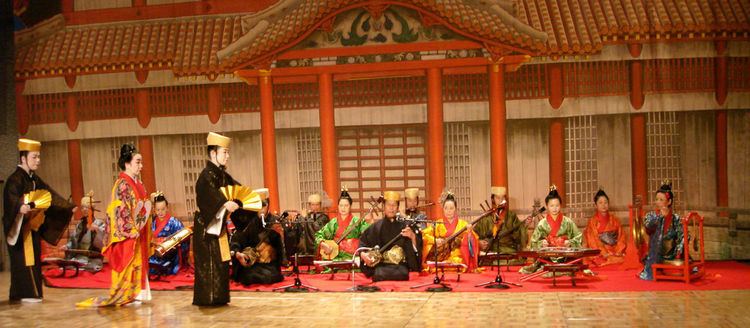 | ||
Okinawan music (沖縄音楽, Okinawa ongaku), also known as Ryukyuan music (琉球音楽, Ryūkyū ongaku), is the music of the Okinawa Islands of southwestern Japan. In modern times, it may also refer to the musical traditions of Okinawa Prefecture, which also covers the Miyako and Yaeyama Islands, and sometimes the Amami Islands.
Contents
Genres
A dichotomy widely accepted by Okinawan people is the separation of musical traditions into koten (classical) and min'yō (folk). Okinawa was once part of the Ryukyu Kingdom. The Yukatchu class in the capital of Shuri developed its high culture while they frequently suppressed folk culture in rural areas. Susumu Kumada added another category, "popular music", to describe songs that emerged after the kingdom was annexed by Japan in 1879.
Classical music
Ryukyuan classical music (琉球古典音楽, Ryūkyū koten ongaku) was the court music of Ryukyu. Uzagaku (御座楽) was the traditional chamber music of the royal palace at Shuri Castle.
The texture is essentially heterophonic using a single melodic line. Pitched accompaniment instruments each play a simultaneous variation on the vocal line.
Folk music
Created and sung by the commoners, folk music gained positive evaluation with the rise of folklorists led by Yanagita Kunio. Folk music is described by the Japanese term min'yō. Since the kingdom was annexed, some members of the former Yukatchu class spread Shuri-based high culture to other areas of Okinawa. Some of such new elements are today seen as part of folk culture.
Okinawa's folk songs are generally accompanied by one (or more) sanshin.
Yunta (ユンタ) is a genre of folk song originating in the Yaeyama Islands. The verses and choruses of the song are sung alternately by the men and the women. The word origin of yunta is said to be from yumi uta (読み歌, "reading song") or yui uta (結い歌, "tying/knotting song").
The suffixes -ondo and -bushi (both meaning "song" or "melody") may also be attached to the title of folk songs, however songs named without these clarifiers are more common. Eisa and kachāshī are Okinawan dances with specific music styles that accompany them.
Warabi uta (童歌) is a general term for nursery rhymes and children's songs.
New folk songs
"New min'yō" (新民謡, shin min'yō), composed in the style of traditional Okinawan min'yō, have been written by several contemporary Okinawan folk musicians such as Rinshō Kadekaru, Sadao China, Shoukichi Kina, Seijin Noborikawa, and Tsuneo Fukuhara. These songs are often heard in contemporary pop music arrangements. Haisai ojisan (ハイサイおじさん), with music and lyrics by Shōkichi Kina, is typical of this genre.
Okinawa's (new) folk songs are sometimes referred to as shima-uta. The term comes from the Amami language and was introduced in the 1970s. It was originally a genre of songs from the Amami Islands.
Okinawa pop
The music of Okinawa came under the influence of American rock music beginning with the end of World War II. Many musicians began to blend the Okinawan folk music style and native instruments with those of American popular and rock music. This is called "Uchinaa pop". One example is Ryukyu Underground, who combine both classical and folk music with modern Dub music.
Instrumentation
The instrument that defines Okinawan music is the sanshin. It is a three-stringed lute, very similar to the Chinese sanxian and a precursor to the Japanese shamisen. The body is covered in snake skin and it is plucked with a plectrum worn on the index finger.
Okinawan folk music is often accompanied by various taiko drums such as shime-daiko (締太鼓), hira-daiko (平太鼓), and paaranku (ぱーらんく). Paaranku, a small hand-held drum about the size of a tambourine, is often used in eisa dancing.
Other percussion instruments such as sanba (三板), yotsutake (四つ竹) and hyōshigi (拍子木) can often be heard in Okinawan music. Sanba are three small, flat pieces of wood or plastic that are used to make rapid clicking sounds, similar to castanets. Yotsutake are two sets of rectangular bamboo strips tied together, one set held in each hand, clapped together on the strong beat of the music. Traditionally they have been used in Ryukyuan classical music, but recently they have been used in eisa dancing.
A group of singers called a hayashi (囃子) often accompanies folk music, singing the chorus or interjecting shouts called kakegoe (掛け声). Also finger whistling called yubi-bue (指笛) is common in kachāshī and eisa dance tunes.
Additional instruments are often used in Ryukyuan classical music, and sometimes incorporated in folk music:
Tonality
The following is described in terms used in Western disciplines of music.
Music from Okinawa uses tonal structure that is different in music from Japan and Amami, in particular the intervalic content of the scales used.
The chief pentatonic scale used in mainland Japan, for example, uses scale degrees 1, 2, 3, 5, and 6, also known as Do, Re, Mi, So, and La in the Kodály system of solfeggio. This structure avoids half step intervals by eliminating the fourth and seventh scale degrees.
In contrast, music from Okinawa is abundant in the half steps. Common structures used in Okinawan music are a pentatonic scale utilizing scale degrees 1, 3, 4, 5, 7, or Do, Mi, Fa, So, Ti, or a hexatonic scale with the addition of the second scale degree, 1, 2, 3, 4, 5, 7, or Do, Re, Mi, Fa, So, Ti. Half steps occur between the third and fourth (Mi and Fa), and also the seventh and first (Ti and Do) scale degrees. In particular, the interval from 7 to 1, or Ti to Do is very common. A folk tune can often be recognized as being Okinawan by noting the presence of this interval.
